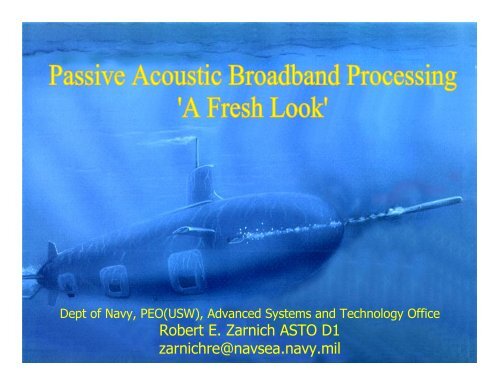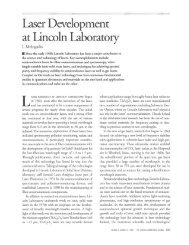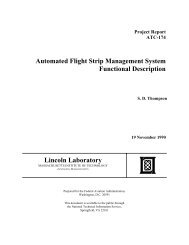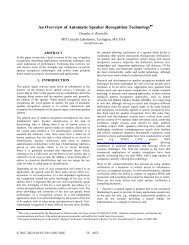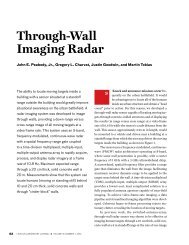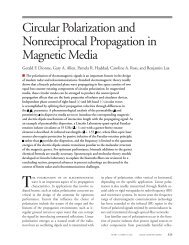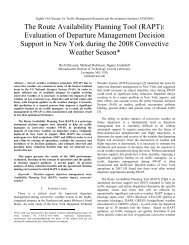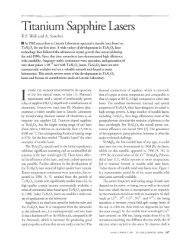Robert E. Zarnich ASTO D1 zarnichre@navsea.navy.mil
Robert E. Zarnich ASTO D1 zarnichre@navsea.navy.mil
Robert E. Zarnich ASTO D1 zarnichre@navsea.navy.mil
Create successful ePaper yourself
Turn your PDF publications into a flip-book with our unique Google optimized e-Paper software.
'HSW RI 1DY\ 3(2 86: $GYDQFHG 6\VWHPV DQG 7HFKQRORJ\ 2IILFH<br />
5REHUW ( =DUQLFK $672 '<br />
]DUQLFKUH#QDYVHD QDY\ PLO
• In the History of War the Submarine<br />
Commanding Officer is the only Blind<br />
Combatant<br />
• Combat System Information<br />
Dependent on Processing but<br />
Commonly Checked Visually<br />
• The Sonar is the Eyes of the<br />
Submarine<br />
• ‘Broadband’ Sonar is Context<br />
– Scene Management<br />
• Desired Characteristics of<br />
‘Broadband’<br />
– Summary of All Contacts<br />
– Intuitive Format<br />
– Detail vs Clutter (PD vs PFA) Situational Awareness<br />
new<br />
Time<br />
~60<br />
min<br />
old<br />
forward cos(Bearing) aft<br />
(0 relative) (180 relative)
Array<br />
Data<br />
Beamform<br />
(1) Spectral Weight<br />
Second Generation Passive Broadband<br />
Spectral<br />
Weight<br />
(1)<br />
Spatial<br />
Normalizer<br />
(2)<br />
Non-Linear<br />
Quantization<br />
(3)<br />
Display<br />
w-spectral(f,t) = f( E[ SNR(f),t ] ) - BQQ-5 used 2 modes of fixed Eckart Weighting<br />
with 3 integration times*<br />
(2) Spatial Normalizer<br />
w-spatial(θ n,t) = g(θ n-D, … , θ n-O, θ n+O, … , θ n-D, t) - Split Window Averages with a<br />
Gap<br />
(3) Non - Linear Quantization<br />
w-power = h( CDF(Power)) - Fixed Histogram Intensity Map<br />
* Fixed “Optimal” Weighting Proved Not Be- A Major Deficiency<br />
Processing Reminiscent of H0 vs H1 Single Signal Testing followed<br />
by a Graphical Rendering of Test Statistic
Major Changes<br />
Third Generation Passive Broadband<br />
• Recognition of Change in Threat Bands of Interest and Environment<br />
• Clutter Mitigation Through Resolution<br />
• Adaptive Beamforming<br />
Contact of Interest
Array<br />
Data<br />
Fore-Aft<br />
Beamform<br />
(1)<br />
(1) Front-Aft Beamforming<br />
Third Generation Passive Broadband cont.<br />
Temporal<br />
Whitening<br />
(2)<br />
Correlation Based<br />
Correlation<br />
Interpolation<br />
(3)<br />
Quantize<br />
&<br />
Display<br />
Adaptive Beamformer. Array Split into First N/2 and Second N/2 Elements, Highly<br />
Overlapped. Beam Space, 7 DOF, Distortionless, with Single Pattern Soft Const.<br />
(2) Temporal Whitening - Smoothed Coherence Transform (SCOT), (Carter et.al.)<br />
w(B M(FORE) , B M(AFT),f,t) =<br />
⎜⎛<br />
BM ( Fore)<br />
( f , t)<br />
* BM<br />
( Aft ) ( f , t)<br />
⎝<br />
(3) Interpolation - Up-Sample to Smooth Coarse Information - Improves Visual Quality<br />
High Resolution in Bearing Space<br />
Eliminates ‘Wash-Out’ Effects of Strong Narrow Band Interferers<br />
Stable Through Maneuvers:<br />
Self Normalization and Reduced Array Distortion Mismatch (Half Aperture)<br />
⎟⎞<br />
⎠<br />
−1
Array<br />
Data<br />
Beamform<br />
Third Generation Passive Broadband cont.<br />
Normalize<br />
Peak Pick<br />
(1)<br />
Fine Bearing<br />
Interp<br />
(2)<br />
(1) Normalize and Peak Pick in Frequency<br />
Sub-band Peak Energy Detection (SPED)<br />
Coarse Normalization (De-trend) and Identify all Peaks over Clutter Threshold.<br />
(2) Fine Bearing Interpolation<br />
Peak assigned to Best Bearing in Grid. Grid Size > # Elements<br />
(3) Accumulate over Frequency<br />
Sum over Frequency. 2 Methods, Binary and Power<br />
(4) Spatial Normalizer<br />
Accumulate<br />
over Freq<br />
(3)<br />
Spatial<br />
Normalizer<br />
(4)<br />
Quantize<br />
&<br />
Display<br />
w-spatial(θ n,t) = g(θ n-D, … , θ n-O, θ n+O, … , θ n-D, t) - Split Window Averages with a Gap<br />
High Resolution in Bearing<br />
Able to Eliminate ‘Wash-Out’ Effects of Strong Narrow Band Interferers, While<br />
Retaining Sensitivity to Narrow-Band Dominated Contacts
True<br />
Spatial Spectrum<br />
Spatial Spectrum<br />
Freq vs Bearing<br />
Power->Color<br />
Peak Picked<br />
Spatial Spectrum<br />
Summed Peaks<br />
Summed Raw Spectrum<br />
(Scan)<br />
Summed Raw Spectrum<br />
Summed Peaks<br />
Power<br />
Freq<br />
Freq<br />
Power<br />
20<br />
0<br />
-20<br />
20<br />
40<br />
20<br />
40<br />
20<br />
0<br />
-20<br />
SPED Processing Example - Rx Known<br />
48 Element Array, 6 Signals, 44 Frequency Bins, 400 Bearing Bins,<br />
Flat Temporal Spectrum<br />
-3 -2 -1 0 1 2 3 4<br />
-3 -2 -1 0 1 2 3<br />
-3 -2 -1 0 1 2 3<br />
-3 -2 -1 0 1 2 3<br />
-3 -2 -1 0 1 2 3 4<br />
W a ve Nu m b e r * fo /f<br />
0<br />
-10<br />
-20<br />
0<br />
-10<br />
-20<br />
15<br />
10<br />
5<br />
0<br />
PP Sum<br />
Raw Sum
Observations<br />
• Deduction - Broadband is Fundamentally a Direction Finding Problem<br />
– Direction Finding is:<br />
First - Signal Detection<br />
Second - Signal Direction of Arrival Estimation<br />
– Good Direction Finding is Sensitive, Highly Resolved and Precise<br />
• Why are the New Techniques Working<br />
– Detail Not Clutter, Resolution is Everything<br />
– Not Constructed as a “Matched Receiver/Detector”, More Data, Less Theory<br />
• Optimality versus Robustness - Always a Trade Off<br />
– Matching Expected Spectrum to Targets of Interest is not Practical, Targets<br />
Change, More Importantly The Environment is Anything but Fixed<br />
– Submarine Sonar Must Find Things Other than Submarines, e.g. P-D<br />
• Thesis - Room for Performance Enhancement if The ‘Intent’ of the SPED<br />
‘Broadband Process’ Were Maintained With Support From a Higher<br />
Resolution Front End<br />
– More Like Direction Finding Than Beamforming
Array<br />
Data<br />
Covariance<br />
Estimate<br />
Fourth Generation Passive Broadband ?<br />
Generalized Direction Finding Based ‘Broadband’<br />
Direction<br />
Finding<br />
Accumulate<br />
over Bands<br />
Spatial<br />
Equalization<br />
Quantize<br />
&<br />
Display<br />
Objective - Exploit SPED’s Concept with Higher Resolution Front End and Novel<br />
Accumulation Schemes While Providing Robust Performance Even During Turns<br />
Covariance Estimate - 20 second Exponentiated Average, Exploit Conjugate Symmetry,<br />
add -10dB Diagonal Loading Relative to Average Element Power. (Experimentation)<br />
Direction Finding - Quadratic Spectral Capon Estimation (MVDR) With ~10*N Samples<br />
From -1 to 1 in u-space. Subspace Approach, Spectral MUSIC, Had Major Sensitivities To<br />
Model Order Variations.<br />
Accumulate Over Bands - Power Summing Method Chosen Based On Empirical Results.<br />
Spatial Equalization - Traditional Technique Avoided Due to Limited Time to Prepare and<br />
Runtime Impact. Non-Traditional Technique Discussed During Graphic<br />
Quantize & Display - 10*log10(Accumulated Power), MATLAB imagesc for Rendering
Representative Data Case III<br />
ED - CS Band 1 ED Band 1 CC Band 1
Representative Data Case III<br />
ED Band 1 Spectral DF Based BB 5sec Rx Band 1
5 sec. R x<br />
Bounds of Stationarity ?<br />
20 sec. R x
20 sec. R x<br />
Bounds of Stationarity ?<br />
60 sec. R x
Data Case III<br />
ED Band 1 Spectral DF Based BB Band 1
1<br />
0<br />
f start f stop<br />
=<br />
Spectrum?<br />
f start f stop
SSP<br />
Short Course In Ocean Acoustics<br />
Art, Ira, Please Forgive Me
for every cell,<br />
if Cell == BLACK,<br />
Cell = Pea Green<br />
else,<br />
swap(Green, Blue),<br />
Cell = Cell<br />
max(Cell)<br />
end_if<br />
end_for<br />
Data Case III<br />
Maximized Intensity, Neutral Background, (Swap Green and Blue)
Data Case II<br />
ED Band 1 Spectral DF Based BB Band 1
Data Case II
Data Case II<br />
Maximized Intensity
Data Case I<br />
ED Band 1 Spectral DF Based BB Band 1
Data Case I<br />
ED Band 1 DF Based BB Band 1 CC Band 1
Data Case I<br />
ED Band 1 Spectral DF Based BB Band 1
Data Case I<br />
ED Band 1 Spectral DF Based BB Band 1 - Maximized Intensity
Summary<br />
• This Brief Study Indicates There is Still Substantial Processing Gains<br />
Available to Enhance Broadband System Performance<br />
• Thesis That Exploiting Direction Finding Technology Would Enhance<br />
Performance Proved True<br />
• Need Robust Practical Approaches for Exploiting Propagation<br />
Observables Due to Environmental Effects<br />
– Could Quickly Generate Vital Tactical Information<br />
• Work Needed to Extend Integration Time Beyond Integration Periods of<br />
Physical Stationarity and Conventional Wisdom<br />
• Work Needed to Formulate Better Rendering Schemes<br />
– Coloring/‘Normalization’ to Worked But Could be Much Improved<br />
• Thanks<br />
– <strong>ASTO</strong>/PMS425, CAPT/Dr. J. Polcari<br />
– APB Signal Processing Working Group (SPWG), DSR<br />
– Prof’s K. Bell, H. L. Van Trees<br />
– You for Your Attention


